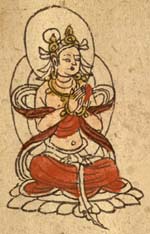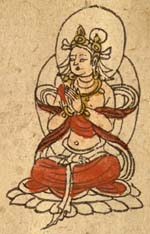
The History
of Buddhism


|
The History
|

|
Buddhism in IndiaThe Buddha lived and taught in the fifth or fourth century BCE. According to the Buddhist tradition, the Buddha had been travelling the path to enlightenment throughout many previous lives. The stories of these previous lives form the Jataka tales. In the life in which he became enlightened, it is said that the Buddha was born as a prince called Gautama. He enjoyed a life of royal luxury until the age of thirty, when he left his father's palace to search for enlightenment. Eventually, the Buddha achieved the enlightenment which he believed to be the state of ultimate freedom from suffering, nirvana. He preached his doctrine in the city of Sarnath, in northern India, and those who listened to his sermons became his first followers. From these grew the Buddhist monastic community, the Sangha.
After the Buddha's death, the Sangha held several councils which standardised the oral teachings which the Buddha had given during his lifetime into a collection of scriptures called sutras. The Sangha grew in size and, at the same time, gradually split into several different schools. In the third century BCE, King Ashoka (268-232 BCE) converted to Buddhism, and became its most powerful patron. Ashoka was the ruler of the Mauryan Empire, which in his time came to encompass most of the Indian subcontinent. As well as strengthening the monastic communities within his kingdom, Ashoka sent missionaries to countries further afield, including Bactria, at the western edge of Central Asia. Buddhism flourished and developed in India over the course of the first millenium CE, enriched by the emergence of the Mahayana and then the Vajrayana. But invasions from the northwest, and a Hindu renaissance in the south meant that the influence of Buddhism in India diminished. It was finally ended by a number of invasions from Afghanistan. The Muslim invaders destroyed Buddhist institutions, the most significant being the university of Nalanda, which fell at the end of the twelfth century. Buddhism in Central AsiaThe first step in the transmission of Buddhism into Central Asia was the missionary activity encouraged by King Ashoka in the third century BCE. By the first century CE, Buddhism was well established in Bactria and Gandhara, and patronised by the Kushana Empire which ruled these areas. As the Empire's sphere of influence moved eastward along the Silk Road, so did Buddhism. Some Buddhist travellers took this route all the way to China. At this time, the oasis town of Kucha on the mid-point of this route became an important centre of Buddhism.
Initially the earlier form of Buddhism, the Shravakayana, was transmitted into Central Asia along these routes. Then from the first century CE, Mahayana Buddhism was introduced into Central Asia. A different route became important in this transmission: from Gilgit, in the area now known as Kashmir, in Northwest India, Buddhism came to the city-state of Khotan, and remained there for several centuries. From here, Mahayana Buddhism travelled to China. From the seventh century CE onwards, Vajrayana Buddhism entered Khotan, again from Northwest India. (Click here to see a map showing the two routes). Most of the other peoples established in Central Asia also adopted Mahayana Buddhism, to a greater or lesser extent, during this period. In the first centuries CE, the Kucheans and Sogdians were influenced by Buddhism, and the Kucheans in particular assisted in the spread of Buddhism eastwards towards China. As their empire expanded into Central Asia in the seventh century, the Tibetans also came into contact with the Buddhism of Central Asia, an important factor in the conversion of Tibet into a Buddhist country. Towards the end of the first millenium CE, the Uighur Turks moved into the area once occupied by the Kucheans, and converted to Buddhism. Finally, in the tenth century, the empire of the Tanguts expanded to take in the eastern end of the Silk Road, and the Tanguts became the last of the Buddhists of the Silk Road. Gradually, towards the end of the first millenium CE, Chinese power in Central Asia declined and the Mongolian and Turkic influence increased. This promoted the spread of Islam and the decline of Buddhism, which led to its eventual disappearance from Central Asia. With the fall of the Tangut empire to Genghis Khan in 1227, Buddhism all but disappeared from the Silk Road. |
|
Chinese Buddhism | Khotanese Buddhism | Kushana Buddhism | Tibetan Buddhism |
|
Other followers of Buddhism | Buddhist Travellers | Glossary |